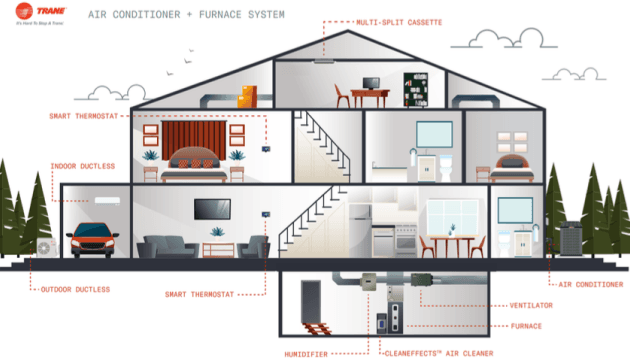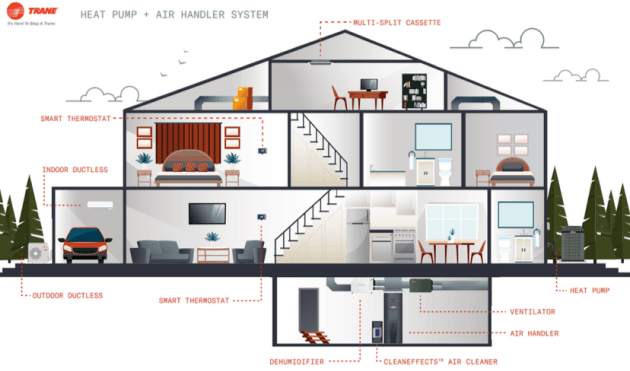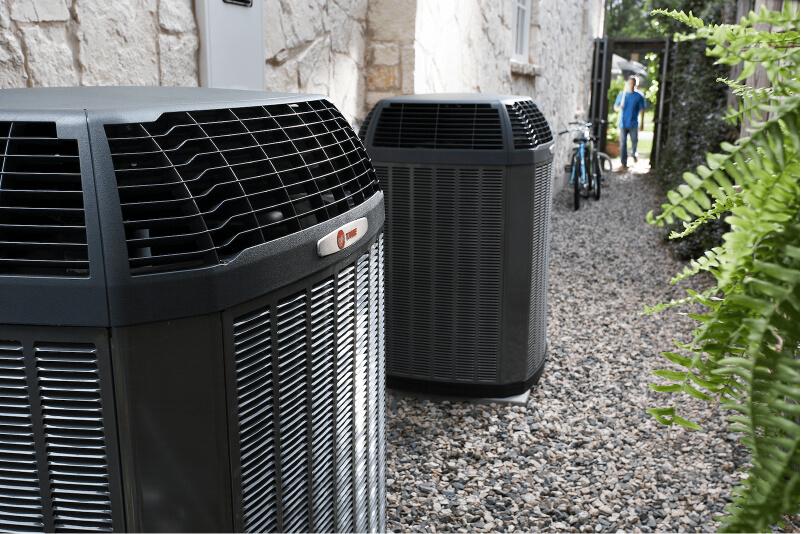Central heating and cooling
In a nutshell, a central HVAC system heats or cools your home by feeding heated or cooled air through your ductwork. While the process seems simple, getting your home to the perfect temperature requires a lot of moving parts with a lot of different components at play.
Understanding the central heating and cooling processes will help you better maintain your HVAC system. Once you know the basics, you’ll know exactly what’s going on in your home the next time you hear your HVAC device kick on. Learn about HVAC system options and the heating and cooling process below, and watch this helpful video to get the basics on what HVAC is and how HVAC systems work.
How does central cooling work?
Air conditioners function by taking heat and humidity from your home and releasing it outside, to ultimately drop the temperature in your home. In order to complete this process, all parts of the central cooling system must work together.
Central cooling system options
In most cases, central air conditioning refers to a split-system air conditioner or a heat pump, both have an outdoor and indoor unit. The indoor and outdoor units work together to distribute cool air through a system of ducts in your home. Together, they are composed of five main parts: a thermostat, an outdoor unit (holds a fan, condenser, and condenser coil), an indoor unit (holds a fan and evaporator coil), copper tubes that connect the outdoor and indoor units, and ductwork throughout the home. While a split-system AC only cools, a heat pump can reverse the flow of refrigerant to heat the home, so the process works in reverse.
A packaged air conditioner is the final type of central cooling. A packaged unit works the same way as a split system AC or heat pump, except the whole unit sits outside the house; there is no equipment inside the home. The packaged unit takes air from your house through the return ductwork, cools it, and then supplies it back to the house through a second set of ductworks, called the supply ductwork.

Central cooling process
Central cooling kicks off when a thermostat senses that the temperature in your home needs to be changed. In the case of central cooling, the thermostat will alert your cooling unit that the temperature needs to drop, and all parts will work simultaneously to get your home to your desired temperature. Once the systems are alerted, they take these steps to cool your home:
- A fan from the indoor portion of your AC moves room temperature hot air out of your home.
- This air is filtered, so dust, lint and debris are taken out
- The filtered, hot air is blown over the evaporator coil, a portion of your air conditioner that gets filled with liquid refrigerant. The evaporator coil absorbs the heat from the air, which turns the refrigerant into a gas.
- The newly cooled air is pumped back into your home via ducts.
- While that cool air is being put into your home, the heat that was recently absorbed needs a place to go, too. So, the heated, gaseous refrigerant passes through a copper tube into the outdoor portion of your air conditioner.
- The refrigerant is put into the compressor, which pressurizes the gas and sends it to the condenser coil.
- The condenser coil releases the heat that used to be in your home from the refrigerant, turning it back into a liquid.
- The process starts again.
How does central heating work
Central heating systems can work in the same general way as central cooling systems by moving air around to change the temperature in your home. Instead of moving hot air out, central heating systems move hot air in to get your home to your desired temperature, but keep in mind this isn’t always the case. Depending on which central heating system you own, your HVAC device might actually be producing its own heat.
Central heating system options
There are two main options for central heating systems: heat pumps and furnaces.
Furnaces
Furnaces work by burning a natural fuel source to make heat from scratch and then distribute that heat through ducts. Furnaces work the best when the temperature outside is really low (below 50°F), because they produce hot heat at a relatively fast pace.
Heat pumps
Heat pumps work throughout the year in all temperatures and can switch between heating and cooling functions depending on the temperature. Heat pumps are ideal for a variety of climates because they can heat and cool under any circumstances.
Central heating process
All central heating processes start the same way central cooling processes do: a thermostat registers the temperature and kicks off the HVAC system.
Heat pumps have the same parts as a split-system air conditioner and work in the same way when they’re needed for cooling. When the temperature drops and a heat pump needs to provide heat, the process essentially reverses itself. Once a heat pump registers the function shift, a reversing valve in the outdoor unit kicks on. This allows the heat pump to absorb heat energy from the outside air and transfer it into the home to warm it up, instead of taking heat from the home and putting it outside to cool it down. The reversing valve is never something that the homeowner needs to touch; the heat pump knows to switch functions on its own!

Furnaces, on the other hand, function in a totally different way than other HVAC products. While the thermostat still kicks off the heating process, all furnaces produce heat from either natural gas, electricity, or fuel oil source, like propane. Depending on the type of unit you own, the fuel source could be located in an outdoor unit or underground, but both will be connected to your home via a pipe. Once your fuel source is connected, the furnace follows these steps to raise the temperature:
- Fuel comes into the furnace through the pipe and lights the furnace burner.
- Cold air from your home is warmed via the fuel within the furnace heat exchanger.
- Exhaust fuel from combustion is piped out of the furnace through a vent.
- A blower fan inside the furnace directs the newly warmed air through the various ducts in your home.
- More cold air is directed from your home into the furnace via the return ducts.
- The process repeats itself until your home is warmed, at which point the fuel switches off and the furnace stops producing heat.
What steps should homeowners take before installation?
STEP 1
Determine your heating and cooling needs
Do you live in a place where the temperature outside gets close to freezing? If yes, consider investing in a furnace to provide hot, dry heat quickly. Does the temperature where you live stay consistent and mild most of the year? If so, a heat pump could provide the heating and cooling you need all year long. Assess your HVAC needs based on your geographic region, yearly temperature patterns, and home size to ensure you’re installing the right device.
STEP 2
Clear your schedule for installation
Most new HVAC devices take a few hours to a day to install, and it’s important that you’re home for the process in case your technician has any questions for you. In some cases, such as having a furnace installed, installation could take multiple days because furnaces need gas sources. If you don’t have one on your property, your technician will need to arrange for one.
STEP 3
Hire a licensed HVAC professional
When it’s time to install your system, leave it to a licensed HVAC professional. Bonus points for your technician if they have additional credentials, like a NATE certification. Your certified technician will install your system, and they’ll be there to help with things like maintenance and troubleshooting whenever they might be necessary.
Related products

Get helpful HVAC tips in our newsletter
Sign up for our email newsletter to learn helpful HVAC tips and tricks before your purchase your system.Related articles
Contact a local dealer
Dealers can answer questions, help you find the right products for your home, and repair your system.
We’re here to help
Connect with our Customer Care team about your products, warranties, and dealer concerns.
Available Monday – Friday from 7am to 5pm CST
A phone

